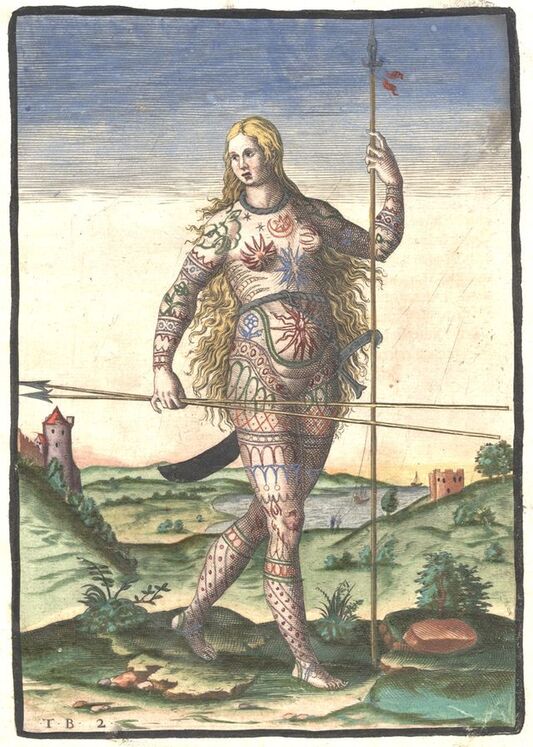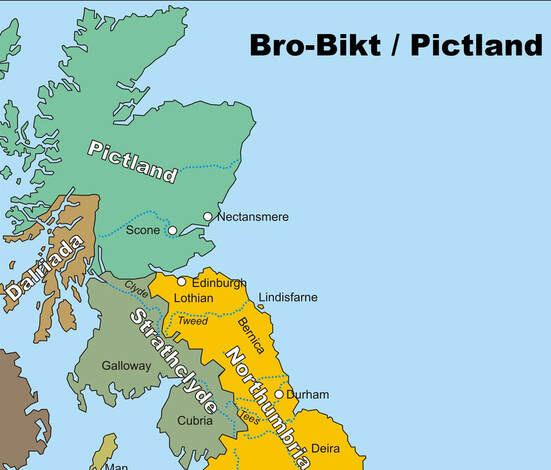|
image credit: Christopher Rynn, University of Dundee Happy Medieval Monday!
In 2017, Professor Susan Black of the University of Dundee, Scotland, was on an archaeological dig on Black Isle, Ross-shire, Scotland with Dr. Christopher Rynn and three PhD students when they discovered the remains of a man buried in a cave. According to Professor Black, he had been brutally beaten to death, but buried carefully, laid in an unusual position, and in a protected location in the back of the cave. Despite his battered skull, researchers at the University of Dundee were able to reconstruct his face using digital imaging. To me, the man looks strikingly modern. Why do I feel a bit surprised? What else should I expect of anyone without worldly trappings affecting their appearance? It's so easy to dehumanize others -- whether in the past or, worse, even in the present. He might have been a bad guy. He might have been cruel. He might have been a great leader, betrayed. We will probably never who he was. But from now on, when I think of the Picts, his face will come to mind. There've been a lot of archaeological discoveries all over Scotland the past few centuries. One very impressive site is the hillfort at Burghead. Radiocarbon dating shows that the fort's construction began as early as the 3rd century, and it's presumed to have flourished between the 4th and 9th centuries. Over 12 acres, it's the largest pictish settlement ever discovered and surely a main center of power for the Picts. Findings at the site show it was a center of both commerce and religion. I owe it to the Picts to write at least one more post about them -- about their writings, their art, their body-paint. But it will be a few weeks. I'll be away and mostly offline for a little while. I can hardly wait to tell you all about it! Be sure to visit the marvelous, medieval ladies Mary Morgan and Barbara Bettis! Wishing you a happy, wonderfully medieval Monday!
6 Comments
"The True Picture of a Woman Picte", engraving by Theodor de Brys, 1588 Happy Medieval Monday! It's been a fascinating time, learning, un-learning, and repeating the process several times over as I've made the acquaintance of the ancient people called the Picts. I have to say, I absolutely love them. No one seems to have a really firm grasp as to who they were, where they were from, or how their language sounded. Possibly the biggest mystery of all -- since they were a known people during recorded history -- is what happened to them? It would seem that someone should know something. Right? Yes, I'm a bit cranky about it. To be fair, it's only because the Picts didn't leave a lot for us to work with -- at least, not a lot has been uncovered yet. But archaeologists continue to make amazing discoveries. They lived in northern and eastern Scotland. Growing evidence shows they were there in the Iron Age which, in Britain, was from roughly 750 BC to when the Romans invaded in the first century AD. It's hard to even know which question to address first! I've decided to go with their name. After all, that is usually first in order when getting to know someone. Then, since it sort of ties in, I will add a few words about where they came from. It's worth pointing out that no one is even sure what they called themselves. I've found a few resources that suggest they might have referred to themselves as the albidosi, as in of the Kingdom of Alba (Scotland). I like that. So where does the name "pict" come in? The most popular theory is that the Romans gave them the name. “Pict” or “Picti” in Latin means “painted people”. It is assumed that this would have been the Romans' way of painting them (no pun intended, but HA) as savages, referring to their blue war paint. But there’s another theory out there that I personally prefer -- that "pict" might be a word of proto-Celtic origin. Cruithni (Irish), prydyn (Welsh), and pretani all mean "ancestors". It's been suggested that pict or pecht (Scottish Gaelic) comes from these old, indigenous words. Ancestors. That brings me to where they came from. Some sources suggest that they came from Scythia. Others, from Ireland. These are the most popular theories, but not the only ones. There's one theory gaining steam that I personally feel is the obvious right choice. Of course, all the work has been done for me. Moreover, what do I know? I'm just getting to know these folks. But I appreciate the suggestion that the picts were indigenous to the land -- indigenous to what is now Scotland. To me, that makes the most sense. Ancestors. Right. To say nothing of Iron Age evidence... I'm going with it. But that's just me. Before I go, I thought to share this astonishing, digital image (University of Dundee) created from the well-preserved remains of a Pictish man. He was handsome and died a violent death. I'll tell you more about him next week. For more medieval fun, be sure to visit these medieval ladies, Barbara Bettis and Mary Morgan. Wishing you a great week ahead! The digitally recreated face of the Pictish man. (Image credit: Christopher Rynn/University of Dundee)
Mysterious History: Medieval Scotland
I was so excited for this week’s Medieval Monday! After struggling through my last few posts -- more to the point, struggling out of the deep and fascinating rabbit holes I had dived into head first – I finally hit upon a plan! The weekend and Monday morning were busy, but I was fine. I knew what I was going to write. I would settle at my computer in the early afternoon and the post would be up in no time. I wasn’t expecting a cable outage. And then, suddenly, our Wi-fi was gone. No internet, no phone for approximately fifteen hours. I’m typing this at four o’clock in the morning. I could have waited -- slept -- but I had so many things on my mind that I finally decided to give up and write. And then I realized that our services had returned. The rest of the neighborhood will doubtless be glad when they wake in a few hours. Onto my Medieval Monday post! The pyramids at Giza, the classic philosophers, the architects of Greece and Rome, runes, hieroglyphics, cuneiform… Some civilizations left us a vast legacy, evidence not only of their existence, but of their way of life, their beliefs and traditions. Others left almost nothing at all. Why is that? It all has to do with the way the people lived, which was, in turn, reliant upon their surroundings. Was it an agrarian society? Warlike? Was the society stable enough to support creativity and education? Were there cities? Was there a wealthy leisure class? An educated one? What’s really fascinating to me is that even of those civilizations that left behind a brilliant collection of writings, immense monuments, and well-preserved artifacts, there’s still so much we don’t know. History is mysterious and (probably) unfathomably vast. Even when broken up into eras, there are innumerable aspects to consider – for every civilization. And so, for study and research purposes, the eras are divided. For the medieval era, we have the early period (500 A.D. to 900), high (900 to 1300), and late (1300 to 1500). The dates are rough/approximate. You can imagine, in this span of 1,000 years, that a lot changed. People and landscapes, conditions and circumstances -- basically, the world -- changed drastically in the course of a millenium. If you consider how much our modern world has changed in just one hundred years, well, you get the idea. For Medieval Monday, in order to keep my blogposts reasonably focused and book-centric, I’m going to largely focus on Medieval Scotland. Moreover, I will concentrate mostly on the Highlands, although not entirely. The posts will be shorter, too, due to my new focus. There was so much more going on than is commonly assumed. But first things first! Are we all clear on the difference between Dal Riata, the Kingdom of Alba, Pictland, and Scotland as we know it today? During the next few Medieval Mondays, we are going to see what we can find out. If you haven't already, be sure to visit Mary's Tavern and Barbara Bettis' blog for more of Medieval Monday! Wishing you a great week ahead! There are more books in this series. I listened to these three audio versions, but I enjoyed the books and characters enough that I will take time to read the rest and hope for more.
My favorite character in the series is the setting. Donna Kauffman describes an absolutely gorgeous, fictional area in the Blue Ridge mountains. But I love ALL the characters. Most make at least brief appearances in all the books. In the series, every couple has to overcome self-imposed obstacles to be together. At times, I found it exasperating, but their hesitance to move forward is probably more realistic than not. In both Blue Hollow Falls and Bluestone & Vine, the characters have to decide whether or not they are willing to make drastic moves in order to be together. In Lavender Blue, Hannah and Wilson must overcome pain and fear of loss. To my surprise, Lavender Blue is my favorite even though it is the heaviest of the three. All three books are beautiful. They encourage choosing joy and life. I did not know that Donna Kauffman died in 2020. She left a wonderful legacy of books behind that I believe reflect her spirit. May she rest in peace. The Blue Hollow Falls series consists of six books: Blue Hollow Falls The Inn at Blue Hollow Falls Bluestone & Vine Lavender Blue Lavender & Mistletoe Under a Firefly Moon |
Romance!It's no secret that I prefer fat HEAs. Where better than in a beautiful romance? Archives
June 2024
Categories
All
NewsletterFrom me to you with a smile. Thank you!You have successfully joined our subscriber list. |












 RSS Feed
RSS Feed